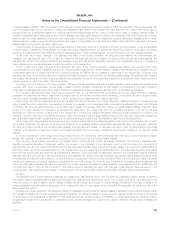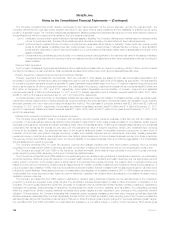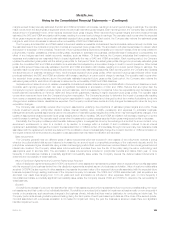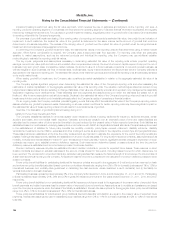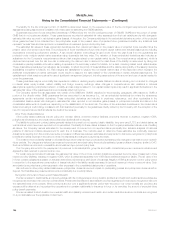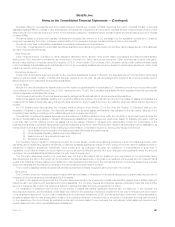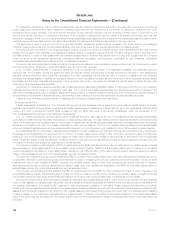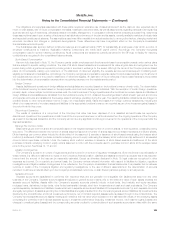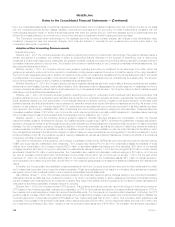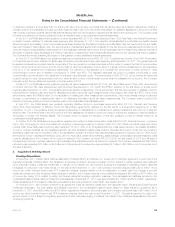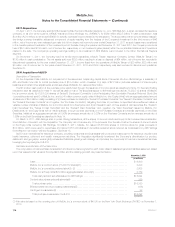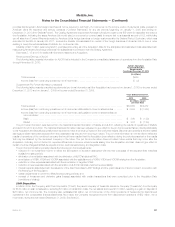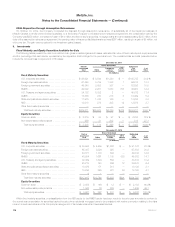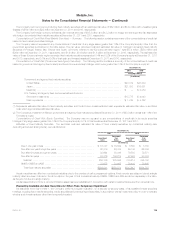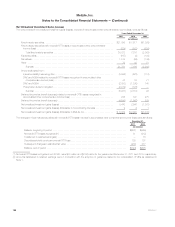MetLife 2011 Annual Report Download - page 115
Download and view the complete annual report
Please find page 115 of the 2011 MetLife annual report below. You can navigate through the pages in the report by either clicking on the pages listed below, or by using the keyword search tool below to find specific information within the annual report.MetLife, Inc.
Notes to the Consolidated Financial Statements — (Continued)
fixed maturity securities of $126 million by sector was as follows: $53 million — ABS, $43 million — RMBS, $17 million — U.S. corporate securities and
$13 million — CMBS. As a result of the adoption of the OTTI guidance, the Company’s pre-tax earnings for the year ended December 31, 2009
increased by $857 million, offset by an increase in other comprehensive loss representing OTTI relating to noncredit losses recognized during the year
ended December 31, 2009.
Effective January 1, 2009, the Company adopted guidance on disclosures about derivative instruments and hedging. This guidance requires
enhanced qualitative disclosures about objectives and strategies for using derivatives, quantitative disclosures about fair value amounts of and gains and
losses on derivative instruments and disclosures about credit risk-related contingent features in derivative agreements. The Company has provided all of
the material disclosures in its consolidated financial statements.
Effective January 1, 2009, the Company adopted prospectively an update on accounting for transfers of financial assets and repurchase financing
transactions. This update provides guidance for evaluating whether to account for a transfer of a financial asset and repurchase financing as a single
transaction or as two separate transactions. The adoption did not have a material impact on the Company’s consolidated financial statements.
Business Combinations and Noncontrolling Interests
Effective January 1, 2011, the Company adopted new guidance that addresses when a business combination should be assumed to have
occurred for the purpose of providing pro forma disclosure. Under the new guidance, if an entity presents comparative financial statements, the entity
should disclose revenue and earnings of the combined entity as though the business combination that occurred during the current year had occurred
as of the beginning of the comparable prior annual reporting period. The guidance also expands the supplemental pro forma disclosures to include
additional narratives. The adoption did not have an impact on the Company’s consolidated financial statements.
Effective January 1, 2009, the Company adopted revised guidance on business combinations and accounting for noncontrolling interests in the
consolidated financial statements. Under this guidance:
‰All business combinations (whether full, partial or “step” acquisitions) result in all assets and liabilities of an acquired business being recorded at fair
value, with limited exceptions.
‰Acquisition costs are generally expensed as incurred; restructuring costs associated with a business combination are generally expensed as
incurred subsequent to the acquisition date.
‰The fair value of the purchase price, including the issuance of equity securities, is determined on the acquisition date.
‰Assets acquired and liabilities assumed in a business combination that arise from contingencies are recognized at fair value if the acquisition-date
fair value can be reasonably determined. If the fair value is not estimable, an asset or liability is recorded if existence or incurrence at the
acquisition date is probable and its amount is reasonably estimable.
‰Changes in deferred income tax asset valuation allowances and income tax uncertainties after the acquisition date generally affect income tax
expense.
‰Noncontrolling interests (formerly known as “minority interests”) are valued at fair value at the acquisition date and are presented as equity rather
than liabilities.
‰Net income (loss) includes amounts attributable to noncontrolling interests.
‰When control is attained on previously noncontrolling interests, the previously held equity interests are remeasured at fair value and a gain or loss
is recognized.
‰Purchases or sales of equity interests that do not result in a change in control are accounted for as equity transactions.
‰When control is lost in a partial disposition, realized gains or losses are recorded on equity ownership sold and the remaining ownership interest is
remeasured and holding gains or losses are recognized.
The adoption of this guidance on a prospective basis did not have an impact on the Company’s consolidated financial statements.
Effective January 1, 2009, the Company adopted prospectively guidance on determination of the useful life of intangible assets. This guidance
amends the factors that should be considered in developing renewal or extension assumptions used to determine the useful life of a recognized
intangible asset. This change is intended to improve the consistency between the useful life of a recognized intangible asset and the period of expected
future cash flows used to measure the fair value of the asset. The Company determines useful lives and provides all of the material disclosures
prospectively on intangible assets acquired on or after January 1, 2009 in accordance with this guidance.
Fair Value
Effective January 1, 2010, the Company adopted guidance that requires disclosures about significant transfers into and/or out of Levels 1 and 2 of
the fair value hierarchy and activity in Level 3. In addition, this guidance provides clarification of existing disclosure requirements about level of
disaggregation and inputs and valuation techniques. The adoption of this guidance did not have an impact on the Company’s consolidated financial
statements.
The following pronouncements relating to fair value had no material impact on the Company’s consolidated financial statements:
‰Effective January 1, 2009, the Company implemented fair value measurements guidance for certain nonfinancial assets and liabilities that are
recorded at fair value on a non-recurring basis. This guidance applies to such items as: (i) nonfinancial assets and nonfinancial liabilities initially
measured at estimated fair value in a business combination; (ii) reporting units measured at estimated fair value in the first step of a goodwill
impairment test; and (iii) indefinite-lived intangible assets measured at estimated fair value for impairment assessment.
‰Effective January 1, 2009, the Company adopted prospectively guidance on issuer’s accounting for liabilities measured at fair value with a third-
party credit enhancement. This guidance states that an issuer of a liability with a third-party credit enhancement should not include the effect of
the credit enhancement in the fair value measurement of the liability. In addition, it requires disclosures about the existence of any third-party credit
enhancement related to liabilities that are measured at fair value.
‰Effective April 1, 2009, the Company adopted guidance on: (i) estimating the fair value of an asset or liability if there was a significant decrease in
the volume and level of trading activity for these assets or liabilities; and (ii) identifying transactions that are not orderly. The Company has provided
all of the material disclosures in its consolidated financial statements.
MetLife, Inc. 111


